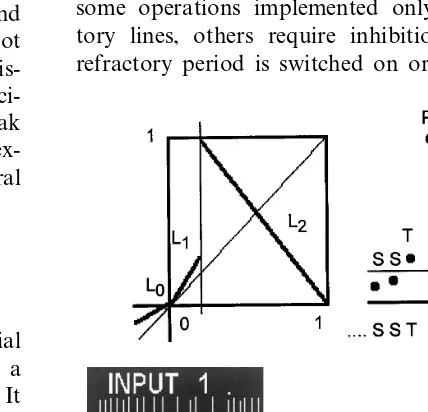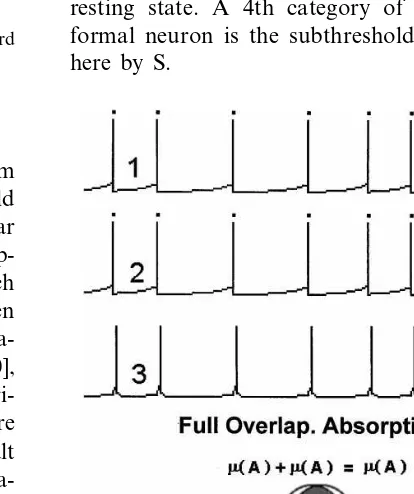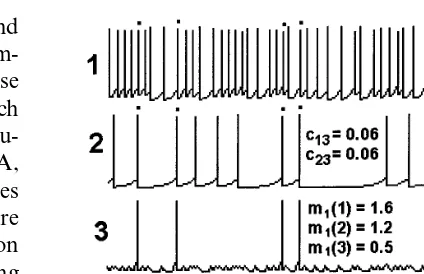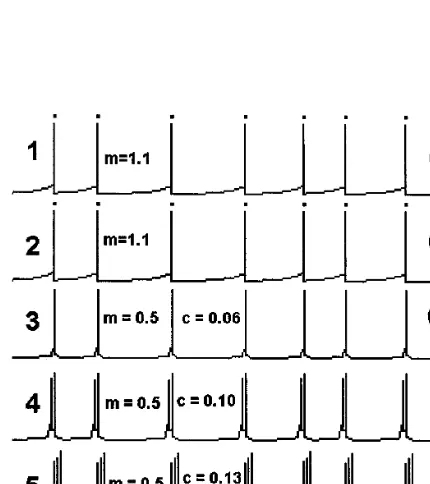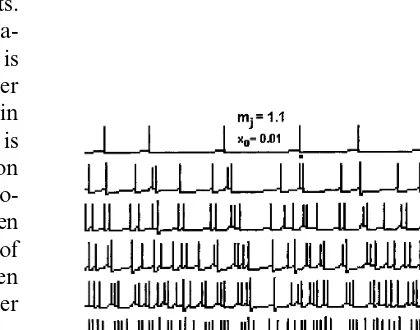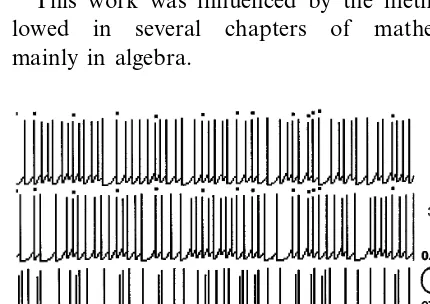Codes, operations, measurements and neural networks
E. La´bos
United Research Organization of Hungarian Academy of Sciences and Semmelweis Medical Uni6ersity,
Neurobiology Research Group,Tu¨zolto´ u. 58,1094Budapest,Hungary
Abstract
Numerous neural codes and primary neural operations (logical and arithmetical ones, mappings, transformations) were listed [e.g. Perkel, D., Bullock, T.H., 1968. Neurosci. Res. Program Bull 6, 221 – 348] during the past decades. None of them is ubiquitous or universal. In reality neural operations take place in continuous time and working with unreliable elements, but they still can be simulated with synchronized discrete time scales and chaotic models. Here, a possible neural mechanism, called ‘measure like’ code is introduced and examined. The neurons are regarded as measuring devices, dealing with ‘measures’, more or less in mathematical sense. The subadditivity — eminent property of measures — may be implemented with neuronal refractoriness and such synapses operate like particle counters with dead time. This hypothetical code is neither ubiquitous, nor universal, e.g. temporal summation (multiplication) causes just the opposite phenomenon, the supra-additivity also with respect to the number of spikes (anti-measures). This is a cause of more difficult neural implementation of OR gate, than that of the AND. Possibilities for transitional mechanisms (e.g. between traditional logical gates, etc.) are stressed here. Parameter tuning might change either code or operation. © 2000 Elsevier Science Ireland Ltd. All rights reserved.
Keywords:Spikes; Pulse code; Neural operations; Logic gates; Arithmetic gates; Set operational gates; Neurons as measuring devices; Subadditivity; Supra-additivity; Burst operations; Single spikes — burst transformations
www.elsevier.com/locate/biosystems
1. Introduction
In this short theoretical communication, the problem of neural codes is extended to that of neural operations. The direct representation of any kind of external information is not examined here. Cases are considered, which show what small neural nets can do with other — already internal — information after it appears at the inputs of neurons or even as a recordable electric neural signal. The considerations are essentially
restricted to neural pulses or spikes. To under-stand what may happen with spike records, a measure theoretical framework is presented. This means that neurons can be regarded as special measuring devices working with ‘measures’. An outline of the relation of this measure-like coding (La´bos, 1976, 1988a) to logical (McCulloch and Pitts, 1943) and arithmetical (Rapoport, 1951; Srinavasan and Bernard, 1976; Roberts and Bush, 1981) operations is given.
Both pulse coding and more the measurability of neural information is not general at all. The limits of operations or neural manipulation with
E-mail address:[email protected] (E. La´bos).
measures will become clearly visible. Concerning neural events other than pulses like synaptic po-tentials are taken automatically into account and these two categories can be separated but formally like in the list of candidate codes Perkel and Bullock (1968)
2. Coding in mathematics, in technics and neural systems are different
The strict technical demands for information and more in cryptosystems are as follows: reliabil-ity, efficiency and security. Concepts like message space (M), cryptogram (ciphertext) space (C), en-coding or enciphering algorithm: EK:MC and the inverse transformation, the decoding or deci-phering procedure DK:MC are defined, both are dependent in cryptography on a keyspace (K). Here, the reversibility is important assuring unique deciphering.
Neural coding theory is not so much exact and Moore et al. (1966) were right saying that techni-cal concepts are at best metaphors ‘when applied to nervous system’, e.g. security is not a demand and invertability of neural transformations is not satisfied. Most probably during synaptic transmis-sion, information is regularly lost. Instead of deci-phering inside neural systems better to speak about neural maps by which information is ex-tracted. That is why beyond neural coding, neural operations are emphasized.
3. Simulation tool
Simple operations were simulated with special spiking units. Mathematically, such a unit is a piecewise linear interval map (PLIM; Fig. 1A). It is a chaotically firing, neuron model called univer-sal pattern generator (UPG; details see in La´bos, 1984, 1988a,b, 1998; La´bos et al., 1992). These formal nerve cells have synchronized discrete time scales, and an infinitude of a single real number state variable xk failing in or in the neighbour-hood of the interval [0, 1]. The consecutive states are computed by iteration of that PLIM function, usually including one line for subthreshold and a
2nd line for suprathreshold values. The two regimes are separated by a threshold parameter. Since xkcan be negative (due to after-potential or inhibition), a 3rd line is also used. Anyhow xk+l=mjxk+bj is the motion equation in each subinterval to which values coming from other neurons are weighted and added. If m\1 for the subthreshold domain, then the unit is autoactive, otherwise it is a passive follower. In standard case one stable or unstable nodal equilibrium point and a suprathreshold unstable focal singularity is built in (see Fig. 1A).
Interneuronal influences are controlled by switching on or off refractoriness of the follower neuron. The duration and strength of this dead or less responsive period can be arbitrarily modified. Thus subthreshold processes, dead time, after-po-tential, firing rate, adaptation, autoactivity or resting state stability are easily changed. So it is possible to study the effects of these changes. A higher order linear recursion may introduce more than one time constant for subthreshold pro-cesses. Connecting identical or different units, some operations implemented only with excita-tory lines, others require inhibition. When the refractory period is switched on or off, its
ence can be investigated. Also the effect of propagation through interconnecting lines can be adjusted. In fact, subthreshold changes van-ish, do not propagate, while spikes do. How-ever, the decremental axonal propagation occurs rarely even in the animal kingdom. Anyhow, the propagation of subthreshold values can be set-tled on or off and so examined. Thus a bit less conventional interconnection matrices may emu-late this propagation control too.
4. Neurons (receptors) as measuring devices: counters with dead time
In mathematics (with simplification) a func-tion called ‘measure’ has the following proper-ties: (1) it is real number valued function, defined on some set; (2) it is subadditive, addi-tive only for disjoint sets; and (3) usually not negative. Eminent quantities like length, area, volume, probability, cardinality (like counts) and with restriction the Shannonian negentropy, etc., can be regarded as measures. If A and B are two measurable sets, m [A] and m [B] are their measures, A@B and ASB are union and inter-section then the following basic relations hold expressing subadditivity and more:
m[A@B]+m[ASB]=m[A]+m[B] m[A@B]5m[A]+m[B] m[ASB]5min{m[A], m[B]}5
max{m[A], m[B]}5m[A@B]5m[A]+m[B]
Why and how is elementary measure theory applicable (with limitations) to neuronal coding and operations? In casting the sets are time points representing spikes of single or several simultaneous temporal spike records, while mea-sures can be most directly the numbers of spikes occurring in separate records, in a period of ob-servation.
Spikes of a neural record can be replaced un-equivocally by the time of its occurrence time, e.g. by the time point of rising phase of spike at the half way of peak to peak amplitude.
For application of measure theory, first set theoretical operations have to be defined. Union
of representative time points gives union. How-ever, overlap needs a new definition. Overlap of two spike-sets includes those spikes which are near enough in time to each other. These over-lapping spikes occur in different records, their proximity is limited by refractory period and so a common upper limit is valid for spike density of any neural record.
Union or intersection set theoretical opera-tions are carried out with special neurons through excitatory lines. In continuous time scale these operations and disjointedness need redefinition in which the refractory cycle during and after spike plays a role in the realization of subadditivity. These concept are called o-union, o-intersection and o-disjointedness, where o is the
dead, unresponsive time, constant for simplicity. When through excitatory input lines converging on a neuron, spike trains arrive, then after the first evoked output spike in an o tail-period of
time all incoming spikes are filtered out resulting in at most [T/o] outgoing pulses for a T
obser-vation period: that is in o time only one. Spikes
are reducible to their peak time moment, t, sur-rounded by an unresponsive time. Later spikes coincide with the first one iff they fall onto the t+o interval of the first spike. Thus filtering is
strongly analogous to a particle counter with dead time. Perfect addition of counts may take place only for arrivals outside of dead time fol-lowing any incoming particle (here spikes) and the count is reduced by the number of coinci-dences in the refractory period.
It will be shown that albeit with limitation, this analogy is efficient in case of neurons re-ceiving converging excitatory input lines which carry neural pulses.
Fig. 2. Input sequences being disjoint in time result in a record in which the accurate sum of input spike numbers appears.
different and also that their neuronal implementa-tion often lacks expected mathematical accuracy even if free of noise.
6. Synchrony and responsiveness
The concept of synchrony of events in the everyday language is too narrow. Usually simul-taneity of identical or similar events are consid-ered. In fact, everything is synchronous with something, e.g. a phase locking of two spike records or a repetitive stimulus and firing neu-ronal response is a special case of synchrony: phase 1 of record-1 coincides with phase 2 of record 2.
The pulses generated by interval map of Fig. 1A, consist of a pre-spike, suprathreshold [T], a peak [P] and at least one (or more) distinguished after-peak [A] value or state under or above the resting state. A 4th category of state for each formal neuron is the subthreshold state, labelled here by S.
5. A spectrum of operations
The small computing networks built up from the very flexible units outlined above could demonstrate a multitude of phenomena: (1) clear logical; (2) arithmetical; and (3) measure-like op-erations with transitions between them. Each ‘standard’ unit is adjustable through about ten parameters to influence the output of an opera-tion: 3×2 line parameters [e.g. m=1.1, b=0], two thresholds [e.g. 0 and a=0.1], two flag vari-ables [1 or 0]. In routine cases two or more variable holding units were coupled to result holder or output neuron, i.e. two or more excita-tory lines were converging on a third neuron. Computer experiments demonstrate certain com-plications and also limitations of measuring hy-pothesis. Beyond threshold logical (McCulloch and Pitts, 1943; Muroga, 1971) and arithmetical (Rapoport, 1951; Blomfield, 1976; Srinavasan and Bernard, 1976; Harmon and Lewis, 1966) opera-tions the transitional cases supports the view that these operational categories are not drastically
Thus the consecutive states arising around and during a spike can be written in a compact sym-bolic form as follows: …SSSTPASSS… These distinguishable T, P and A and S states for each records can be coincide with those of other neu-rons, e.g. for two records PP, TP, AP, TT, AA, AT categories of spike or near-spike coincidences exist. These coincidences in case of two or more converging input lines may result in facilitation (potentiation) or depression (filtering). Expressing in terms of spike numbers of any output line the result is a coincidence surplus or deficit if com-pared to the sum of number of spikes carried by the input lines. The output may be greater, equal or smaller than the sum of inputs. These cases are identified by their given names: supra-additivity, additivity or subadditivity. Remark that all men-tioned phenomena are related to the partial or perfect synchrony (PP) of spikes. Spikes (like ev-erything) are always synchronous with something else. Eminent or singular coincidences arise if a peak of spike or its temporal neighbourhood is in synchrony with those states of an other neural record. Traditionally when a singular event coin-cides with a ‘neutral’ one, the coincidence can be forgotten. In case of two neuronal records these are the ST, SP, SA coincidences which do not result to synaptic interaction of converging excita-tory lines.
The partial overlap of pulses is possible and correspond to cases characterized above. There-fore the model is not perfectly synchronous in terms of pulses despite the synchronized and dis -crete time scales. When two peaks of spike are simultaneous, one can be ineffective or on the contrary their effect can be doubled or even multi-plied. When the 2nd spike coincides with the passive period of the other neuron, its effect is killed. Such dead period may extend not only to post-peak refractoriness but also to immediate pre-peak period, already above the threshold but not yet large enough. However, like in reality no subthreshold activity (here the states denoted by S) is followed by inactive period.
Not only the strength of the effect of inputs (operandi) but the sensitivity of a neuron holding the result of an operation can be adjusted so that coincidences results to positive interaction. As it is
Fig. 4. AND — gating of two converging lines is realized almost exactly as was done with threshold logical units. Neces-sary condition are as follows: (1) suitable choice of synaptic weights (cij); and (2) low reactivity of 3rd receiver unit
[m1(3)=0.5 with refractoriness]. It is adequate also for PP,
PT, TP, PA, AP kinds of coincidences whose the definition is in the text. Inverting the 3rd record it can be applied to implement further gates as well.
known, these more sensitive periods are also near in time to a peak of spike just preceding or following.
7. Simulating operations
7.1. Exact and almost exact AND gates
The overlap of two temporal sequential sets of pulses is the set of synchronous spikes. The mea-sure of overlap here is the number of coinciding spikes. This concept of intersection is an extension of set theoretical overlap. Various kinds of coinci-dences so define various kinds of overlaps to which set and measure theory can be carefully and with limits extended.
7.2. Burst to spike transformations
A transformation opposite to that of Fig. 5, is when the offset or onset of a burst is labelled by one or some sporadic spikes (Figs. 6 and 7). The trick is simply to (at least) duplicate a spike record, delay one of them and feed forward the delayed record(s) by a strong enough inhibition (ON-gate). An OFF-gate is obtained if a record is inverted to become a strong inhibitory line, and mixed on a 3rd with its delayed excitatory version. Such small nets can be used as modules in nets recognizing motion or contrast. These two more advanced operations are the temporal and spatial versions of the same stimulus (input) feature, the ‘change’. With a suitable combination motion of a contour also detectable (La´bos, 1977)
Fig. 6. Burst-to-spike transformation: burst-end is marked with few or single spike. Values of subthreshold slopes are given.
7.3. Multiplication mechanisms
Argumentation based on mathematical or tech-nical inspiration leads one to speculate about the possible occurrence of multiplication in neural systems (Rapoport, 1951; Srinavasan and Bernard, 1976). The hypothetical role of an oper-ation like multiplicoper-ation can be a selective amplifi-cation of a signal stream to make it more efficient and specific. In case of spike sequences this may be an increase of number of spikes of which the accuracy seems secondary.
Fig. 5. Spike-to-burst transformation is achieved if a record is (1) duplicated; or (2) fed to a 3rd unit of which the sensitivity is settled either by refractoriness or time constants (via parameter m) or both. This may be a mechanism of multiplica-tion (amplificamultiplica-tion) of any spike record. The m values, i.e. the slopes of subthreshold line in interval map of Fig. 1A, were kept unchanged and strength of synaptic coupling was in-creased. Here, the follower units are not autoactive (mB1).
Fig. 8. If a pacemaker unit (the 1st black circle) drives silent (m=0.5), passively reacting neurons, coupled in a chain by excitatory (positive) synaptic weights, then either a failure of transmission or reliable propagation is expected. A temporal shift of the consecutive records takes place. Multiple spikes also could be selectively obtained if certain followers were adjusted to be more sensitive. Compare to Fig. 9 where the follower units are also pacemakers.
are realized. In case of perfect logical gates the number of 1-s in OR-holding neuron can be com-puted like measure theory predicts: n[OR(input1, input2)]=n[inputl]+n[input2]−n[AND(input1, input2)], where n[X] means the spike counts in the channel X. The subtracted quantity is calledcoin -cidence deficit. The task is to find out how number of synchronous spikes is subtracted automatically if the neurons are not perfect threshold gates, like in reality and here too. A solution is offered by refractoriness and sensitivity adjustments. Increas-ing the weights more spikes appear, but at the same time multiple spikes may arise just at the coincidences. These can be filtered by a delicate tuning of all participating. In Figs. 10 and 11 various cases demonstrate that not easy adjust-ment: the two upper records are the inputs, the lower ones represent trials to adjust coincidence deficit. Here it is explicit the problem: what kind of coincidence we are speaking about? Anyhow, the simple OR-gate appears to be more difficult to reach and due to numerous kinds of coincidence may have also many definitions.
The simplest way to multiply approximately the number of spikes is to decrease threshold, increase sensitivity by rising the subthreshold line slope of the interval map describing dynamics of units. This is applied in Fig. 5 to reach burst representa-tion of coincidences. A different possibility is given if neurons are coupled in a chain. However if a pacemaker neuron drives silent (i.e. stable in resting state) neurons, then the driver activity is simply transmitted (Fig. 8) and no multiplication occurs. As soon as the same — initially synchro-nized pacemakers are coupled into a chain, then desynchronization takes place and the measure of activity is increased (Fig. 9) along the chain, even if some inhibitory is fed back to the first driver unit.
7.4. Gates ‘o6er’ AND-gates — OR gating mixed with burst responses
It is known that in threshold logic (McCulloch and Pitts, 1943; Muroga, 1971) the synaptic weights applied for OR-gate are larger than those for AND-gate. The incoming excitatory lines should be efficient alone in case of OR-operation and should be ineffective alone when AND gates
Fig. 10. A transitional gate. The sensitivity of 3rd unit and also synaptic weights are higher than in case of AND gate (Fig. 4). Two phenomena arise: (1) spikes standing alone in input records also evoke response; and (2) spikes coincidences in channel 1 and 2 may evoke multiple responses, which might make the responding unit firing independently of events in the simultaneous inputs. See burst during silence in 1st and 2nd.
It is the axiomatization. Find and demon-strate basic operations and transformations, re-veal their primary properties, derive consequences and get a complicated computa-tional structure which may interpret low level perceptual, neural or even higher mental compu-tations (see Fienandt and Mousrgaard, 1977; Harris, 1980; Nadel et al., 1989). In present time, no unified theory of perceptual, neural or mental codes and computations exists. The list of more than 30 possible or candidate code mechanisms as it is displayed in the pioneering summary of Perkel and Bullock (1968) is impor-tant but it is so heterogeneous that cannot be easily reduced to a few fundamental ones. The same holds for possible neural operations deal-ing already with encoded external quantities and qualities.
Mathematics suggests mechanisms which can be either pure logical or pure arithmetical or pure set-theoretical or pure measure theoretical ones. For each of these the limitations and non-uniqueness can be convincingly demonstrated. Imperfect and transitional realization of sterile ideal concepts is the most frequent case. For example, we saw that it is easy to adjust the sensitivity of a receiver neuron together with the parameters of transmission to construct a gate between AND and OR gates but it is much more difficult to implement an OR-gate satisfy-ing all demands, includsatisfy-ing measure theoretical ones in terms of the expected number of spikes. In the latter case, for an OR gate a sensitive result holding unit is required. However, a high sensitivity may lead to spurious additional spik-ing which works against the demand that spikes in synchrony have to be represented only once. Thus the required subadditivity is often blocked by non-desired amplification of simultaneous events. This phenomenon justifies why the prob-lem of multiplication is discussed in this presen-tation. Nevertheless, the exact OR gate is realizable in sense of spike counts (the measure) correctly (La´bos, 1988b), but the parameter gap is narrow.
Also no sharp transition is between burst and spike representation of events, while the role of
8. Discussion
This work was influenced by the method fol-lowed in several chapters of mathematics, mainly in algebra.
burst is much less known than their generating mechanisms.
Here we focused on the concept of measure-ment, so measure theory can be applied if sub-additivity works with respect to a given output variable, e.g. the spike counts. But as soon as supra-additivity arises as it does in fact, the ap-plicability of the measuring device concept fails.
The view that neuronal computations cannot be described completely with any specific tool-kit of any chapter of the present day logic or mathematics is here reinforced.
Our aim was to investigate the following question. In what extent and how processes re-gardable automatic measurements are possibly carried out by neurons or nets and ‘used’ in various brain structures?
Parts of an answer to this problem are given below: (1) Tonic sensory channels (receptors) or even central neurons may include the act of measuring supposed that they have S-shaped (sigmoid) response characteristics. This claim follows from a relevant theorem of measure the-ory (Halmos, 1974; Weisstein and Wolfram Re-search, 1996). It says that distribution functions (including S-curves) ‘induce or generate measure spaces’. In fact such neuronal response charac-teristics frequently occur. The step function of threshold gates (=formal neurons) is also a de-generated S-shaped distribution function. Details are here omitted. (2) All integration in mathe-matical sense involves some concept of measure. As soon as a ‘neural integration’ in some sense implies a kind of ‘mathematical integration’ then measures should appear. To go beyond this metaphor, further investigations are required and this do not seem particularly difficult. (3) In neural systems there are mechanisms, good to implement ‘subadditivity’ required for measure-ments: refractoriness, inhibition, adaptation, ac-comodation, habituation, suppression, etc. So both cellular and network tools are indeed avail-able. (4) Mechanisms of opposite direction, like facilitation, potentiation and other anti-suppres-sive happenings do not fit into a ‘neural mea-sure theory’. This may have an independent role: selective amplification which may mean
forced transmission of specific information. Obviously, none of the logical, arithmetical, measure or set theoretical operations are such that to which the remaining operations are fully reducible: neither in mathematics nor in neural systems. Indeed, this reducibility was not ex-pectable at all.
An approach to neural codes through opera-tion can not be complete. It may represent only a restricted description of neural syntax. When investigating a particular or several experimental spike records, an immense amount of crucial data are still demanded like, e.g. other activity records as contexts, also stored information which might be behind these records, etc. So a break-through in neural code theory should be accompanied with a progress in efficient experi-mental data production.
Acknowledgements
The work and participation on NCWS99 was supported by grants of OTKA (T25179) and OMFB Hungarian Foundations for the Promo-tion of Sciences.
References
Blomfield, S., 1976. Arithmetical operations performed by nerve cells. Brain Res. 69, 115 – 124.
Fienandt, K., Mousrgaard, I.K., 1977. The Perceptual World. Academic Press, London.
Halmos, P.R., 1974. Measure Theory. Springer, Berlin. Harmon, L.D., Lewis, E.R., 1966. Neural Modelling. Physiol.
Rev. 46 (3), 513 – 591.
Harris, C.S. (Ed.), 1980. Visual Coding and Adaptability. Erlbaum Publishers, Hillsdale.
La´bos, E., 1976. Continuous and discrete measuring automata as models of real neurons and neuronal networks. In: Szenta´gothai, J., et al. (Eds.), Neuron Concept Today, 1976. Publishing House of Hungarian Academy of Sci-ences, Budapest, pp. 203 – 211.
La´bos, E., 1977. Theoretical considerations of local neuron circuits and their triadic synaptic arrangements (TSA) in subcortical sensory nuclei. J. Neurosci. Res. 3, 1 – 10. La´bos, E., 1984. Periodic and non-periodic motions in
La´bos, E., 1988a. Asynchronous versus synchronous computa-tion in the nervous system and their models. J. Mol. Electron. 4 (1), 67 – 77.
La´bos, E., 1988b. Neuronal operations on asynchronous time scale emulated with synchronous models (chaotic interval maps). In: Trappl, R. (Ed.), Cybernetics and Systems’ 88. Kluwer Academic Publishers, Dordrecht, pp. 983 – 990. La´bos, E., 1998. Spike generating interval maps as neural
units. In: Lansun, Chen, Shigui, Ruan, Jun, Zhu (Eds.), Advanced Topics In Biomathematics; Proc. Int. Conf on Math. Biol. Zhejiang Agricultural Univ., PR of China, 1997. World Scientific, Singapore, pp. 97 – 101.
La´bos, E., Holden, A.V., Zhang, H., 1992. The behaviour of the Lyapunov exponent of a map simulating neural activ-ity. Phys. Lett. A 173, 399 – 406.
McCulloch, W.S., Pitts, W., 1943. A logical calculus of the ideas immanent in nervous activity. Bull. Math. Biophys. 5, 115 – 131.
Moore, G.P., Perkel, D., Segundo, J.P., 1966. Statistical analy-sis and functional interpretation of neuronal spike data.
Ann. Rev. Physiol. 28, 493 – 552.
Muroga, S., 1971. Threshold Logic and Its Application. Wiley-Interscience, New York.
Nadel, L., Cooper, L.A., Cilicover, P., Harnish, M., 1989. Neural Connections and Mental Computations. MIT Press, Cambridge, MA.
Perkel, D., Bullock, T.H., 1968. Neural coding. Neurosci. Res. Program Bull. 6, 221 – 348.
Rapoport, A., 1951. ‘Addition’ and ‘multiplication’ theorems for the input of two neurons converging on a third. Bull. Math. Biophys. 15, 179 – 188.
Roberts, A., Bush, B.M., 1981. Neurons Without Impulses. Cambridge Univ. Press, Cambridge.
Srinavasan, M.V., Bernard, G.D., 1976. A proposed mecha-nism for multiplication of neural signals. Biol. Cybern. 21, 227 – 236.
Weisstein, E.W., Wolfram Research, Inc., 1996. CRC Concise Encyclopaedia of Mathematics (titles on measure): http:// astsun.astro.virginia.edu/-eww6n/math/ and http://math-world.wolfram.com/
